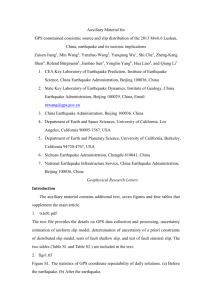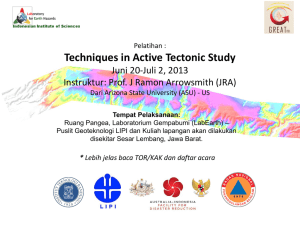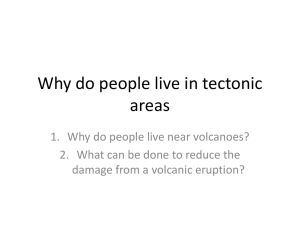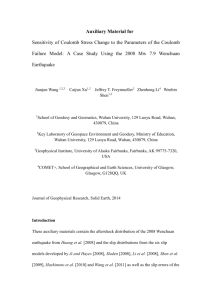Earthquake Recurrencex part1
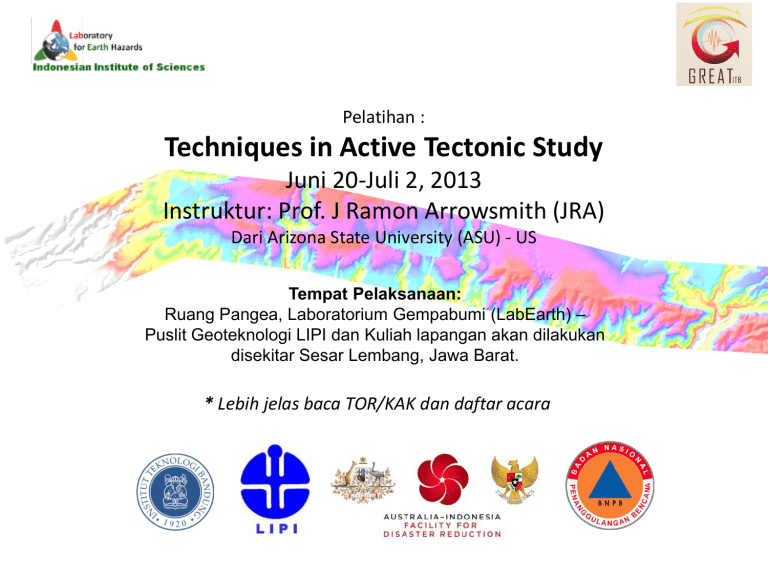
Pelatihan :
Techniques in Active Tectonic Study
Juni 20-Juli 2, 2013
Instruktur: Prof. J Ramon Arrowsmith (JRA)
Dari Arizona State University (ASU) - US
Tempat Pelaksanaan:
Ruang Pangea, Laboratorium Gempabumi (LabEarth) –
Puslit Geoteknologi LIPI dan Kuliah lapangan akan dilakukan disekitar Sesar Lembang, Jawa Barat.
* Lebih jelas baca TOR/KAK dan daftar acara
Earthquake Recurrence
Outline of this lecture
•
Simple models of earthquake recurrence
•
Segmentation
•
Earthquake rate models: Gutenberg-Richter and Characteristic
•
Earthquake recurrence simulation
Simple Earthquake Machine
Subduction earthquake cycle
A. Periodic earthquake model in which stress levels at the time of rupture and after it are known. These yield a predictable time and slip for each earthquake. B. Time-predictable model based on a consistent stress level at which failure occurs. Stress drop and slip magnitude are unpredictable, but given previous slip, time until the next earthquake (with unknown slip) is predictable. C. Slip-predictable model based on a consistent stress level at the end of an earthquake. Given time since the last rupture, magnitude of slip is predictable. Modified after Shimaki and Nakata (1980)
Burbank and Anderson
Burbank and Anderson, 2011, Tectonic Geomorphology, Chapter 4
Burbank and Anderson, 2011, Tectonic Geomorphology, Chapter 4
Basic fault segmentation
Burbank and Anderson
Fault zone is comprised of heterogeneous non coplanar fault surfaces bounding oblate blocks whose geometry and activity varies in time and space
3D mixed mode stepover
Map view mode II step
(bend)
Crosssection view mode III step (bend)
Strong influences on
•
Stress and displacement fields around the fault surfaces
• Further development and linkage
• Fluid flow
•
Rupture dynamics
•
Fault zone strength
Questions:
Geometric
—Fault surface and block shapes and sizes
Time —How long are they active? What is slip history? Block motion history?
Development
—Linkage and evolution of roughness
Predicting the endpoints of earthquake ruptures (I)
Wesnousky, 2006
Predicting the endpoints of earthquake ruptures (II)
“stop light color scheme”
About 2/3 rupture terminations are associated with discontinuities or fault ends
Wesnousky, 2006
Megathrust earthquake segmentation model for
Indonesia region
(Irsyam et.al., 2010)
Estimated maximum magnitude and slip rate of faults in Indonesia
(Irsyam et.al, 2010)
Earthquake magnitude and frequency: Earthquake rate model
1984
“…individual faults and fault segments tend to generate essentially the same size or characteristic earthquakes having a relatively narrow range of magnitudes near the maximum” given fault geometry
Full Rupture of seismogenic width of fault
Zielke and Arrowsmith, 2008
High resolution satellite imagery based offset reconstruction along Fuyun Fault, China
Approximately 2kyr recurrence interval
If we know slip rate du/dt
And we assume u(x) per event
We can get recurrence time u ave or u max per event should also imply length and M
Burbank and Anderson
Synoptic view of continental shear zone (Scholz, 1988)
Burbank and Anderson, 2011, Tectonic Geomorphology, Chapter 4
Modified from Zielke and Arrowsmith, 2008
Burbank and Anderson, 2011, Tectonic Geomorphology, Chapter 4
Modified from Zielke and Arrowsmith, 2008
Thatcher, 1990
So what do these earthquakes look like along the fault over time?
Quasi-static earthquake simulator using elastic dislocations with stress boundary conditions and simple friction produces synthetic earthquake catalogue (900,000 events > 5km 2 over 540kyr; cumulative stress history)
Zielke and Arrowsmith, 2008; Zielke, 2009
Bimodal Seismicity Distribution
Down-dip rupture width RW of small EQs is limited by z p
Rupture of strength barrier z p seismic zone causes activation of full
Abrupt increase in RW and RA at transition from small to large EQs
Abrupt increase in Magnitude
Small vs. Large EQ
RW vs. Freq.
Mag. vs. Freq.
Implies bimodal M, RA, and slip at surface->controlling influence of event on landscape
Moderate M, partial rupture, Gutenberg-Richter
Large M, full rupture, Characteristic
Zielke and Arrowsmith, 2008



